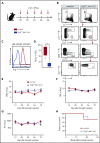Serial transplantation reveals a critical role for endoglin in hematopoietic stem cell quiescence
- PMID: 30593445
- PMCID: PMC6376279
- DOI: 10.1182/blood-2018-09-874677
Serial transplantation reveals a critical role for endoglin in hematopoietic stem cell quiescence
Abstract
Transforming growth factor β (TGF-β) is well known for its important function in hematopoietic stem cell (HSC) quiescence. However, the molecular mechanism underlining this function remains obscure. Endoglin (Eng), a type III receptor for the TGF-β superfamily, has been shown to selectively mark long-term HSCs; however, its necessity in adult HSCs is unknown due to embryonic lethality. Using conditional deletion of Eng combined with serial transplantation, we show that this TGF-β receptor is critical to maintain the HSC pool. Transplantation of Eng-deleted whole bone marrow or purified HSCs into lethally irradiated mice results in a profound engraftment defect in tertiary and quaternary recipients. Cell cycle analysis of primary grafts revealed decreased frequency of HSCs in G0, suggesting that lack of Eng impairs reentry of HSCs to quiescence. Using cytometry by time of flight (CyTOF) to evaluate the activity of signaling pathways in individual HSCs, we find that Eng is required within the Lin-Sca+Kit+-CD48- CD150+ fraction for canonical and noncanonical TGF-β signaling, as indicated by decreased phosphorylation of SMAD2/3 and the p38 MAPK-activated protein kinase 2, respectively. These findings support an essential role for Eng in positively modulating TGF-β signaling to ensure maintenance of HSC quiescence.
© 2019 by The American Society of Hematology.
Conflict of interest statement
Conflict-of-interest disclosure: The authors declare no competing financial interests.
Figures






Similar articles
-
Quiescence of hematopoietic stem cells and maintenance of the stem cell pool is not dependent on TGF-beta signaling in vivo.Exp Hematol. 2005 May;33(5):592-6. doi: 10.1016/j.exphem.2005.02.003. Exp Hematol. 2005. PMID: 15850837
-
Endoglin in human liver disease and murine models of liver fibrosis-A protective factor against liver fibrosis.Liver Int. 2018 May;38(5):858-867. doi: 10.1111/liv.13595. Epub 2017 Oct 23. Liver Int. 2018. PMID: 28941022 Free PMC article.
-
SHP-1 regulates hematopoietic stem cell quiescence by coordinating TGF-β signaling.J Exp Med. 2018 May 7;215(5):1337-1347. doi: 10.1084/jem.20171477. Epub 2018 Apr 18. J Exp Med. 2018. PMID: 29669741 Free PMC article.
-
Bone marrow Schwann cells induce hematopoietic stem cell hibernation.Int J Hematol. 2014 Jun;99(6):695-8. doi: 10.1007/s12185-014-1588-9. Epub 2014 May 10. Int J Hematol. 2014. PMID: 24817152 Review.
-
Dormant and self-renewing hematopoietic stem cells and their niches.Ann N Y Acad Sci. 2007 Jun;1106:64-75. doi: 10.1196/annals.1392.021. Epub 2007 Apr 18. Ann N Y Acad Sci. 2007. PMID: 17442778 Review.
Cited by
-
Impact of CD105 Flow-Cytometric Expression on Childhood B-Acute Lymphoblastic Leukemia.J Blood Med. 2021 Mar 16;12:147-156. doi: 10.2147/JBM.S300067. eCollection 2021. J Blood Med. 2021. PMID: 33758569 Free PMC article.
-
Identification of CD105 (endoglin) as novel risk marker in CLL.Ann Hematol. 2022 Apr;101(4):773-780. doi: 10.1007/s00277-022-04756-4. Epub 2022 Jan 19. Ann Hematol. 2022. PMID: 35044512 Free PMC article.
-
Always stressed but never exhausted: how stem cells in myeloid neoplasms avoid extinction in inflammatory conditions.Blood. 2023 Jun 8;141(23):2797-2812. doi: 10.1182/blood.2022017152. Blood. 2023. PMID: 36947811 Free PMC article.
-
Current concepts on endothelial stem cells definition, location, and markers.Stem Cells Transl Med. 2021 Nov;10 Suppl 2(Suppl 2):S54-S61. doi: 10.1002/sctm.21-0022. Stem Cells Transl Med. 2021. PMID: 34724714 Free PMC article. Review.
-
Immunophenotypic characteristics of multipotent mesenchymal stromal cells that affect the efficacy of their use in the prevention of acute graft vs host disease.World J Stem Cells. 2020 Nov 26;12(11):1377-1395. doi: 10.4252/wjsc.v12.i11.1377. World J Stem Cells. 2020. PMID: 33312405 Free PMC article.
References
-
- Wilson A, Laurenti E, Oser G, et al. . Hematopoietic stem cells reversibly switch from dormancy to self-renewal during homeostasis and repair. Cell. 2008;135(6):1118-1129. - PubMed
-
- Gardner RV, McKinnon E, Astle CM. Analysis of the stem cell sparing properties of cyclophosphamide. Eur J Haematol. 2001;67(1):14-22. - PubMed
Publication types
MeSH terms
Substances
Grants and funding
LinkOut - more resources
Full Text Sources
Medical
Research Materials
Miscellaneous

